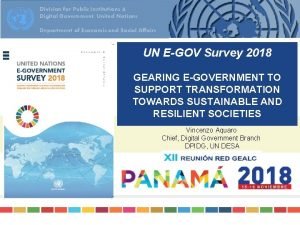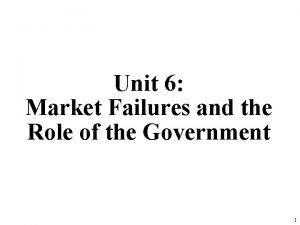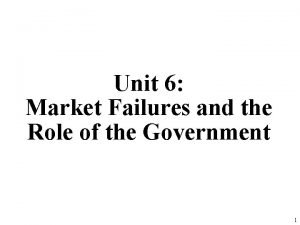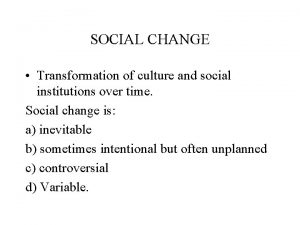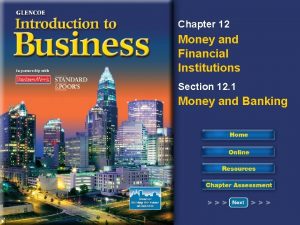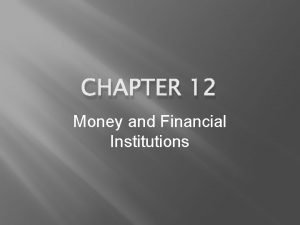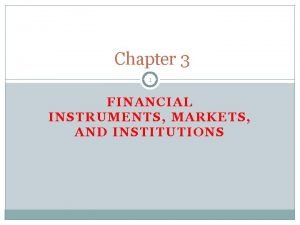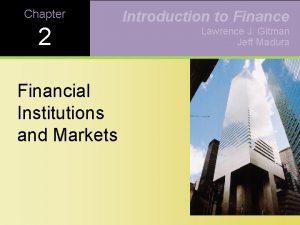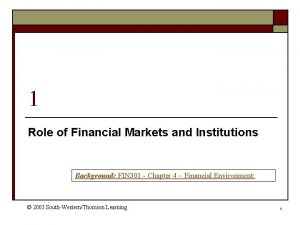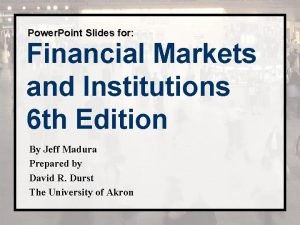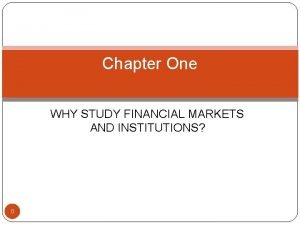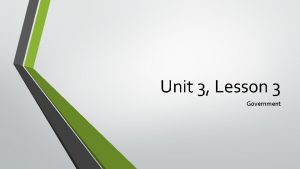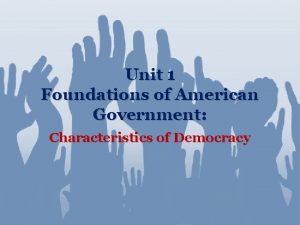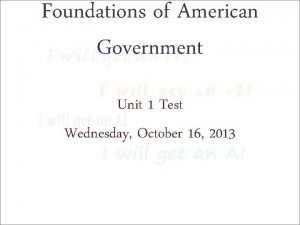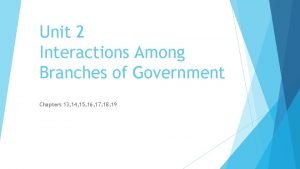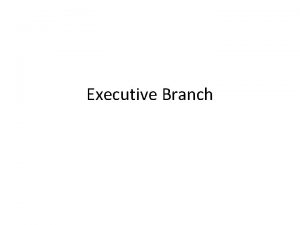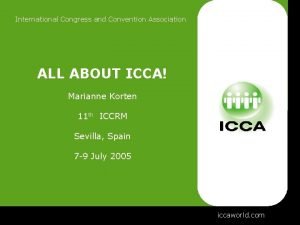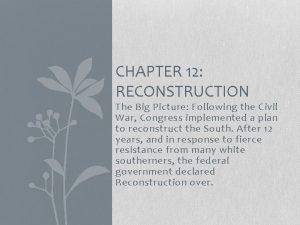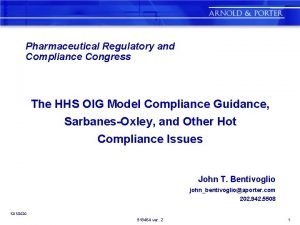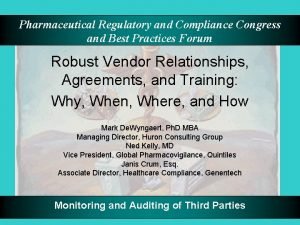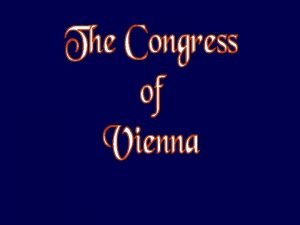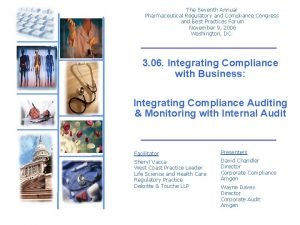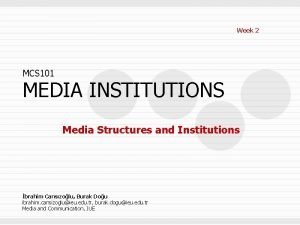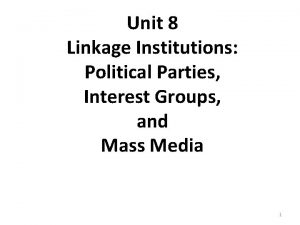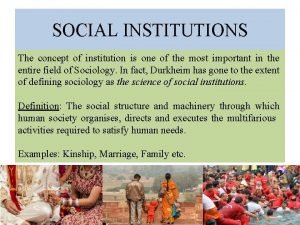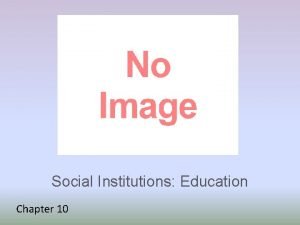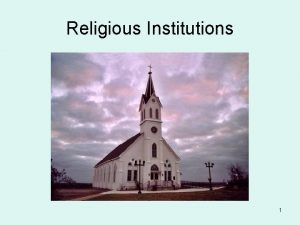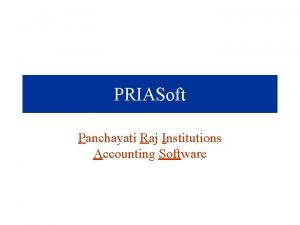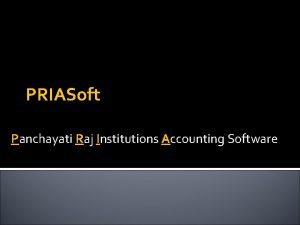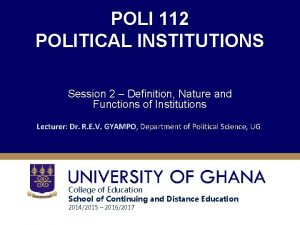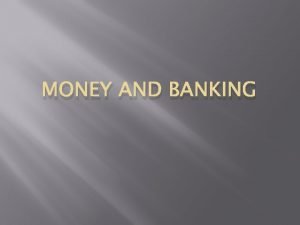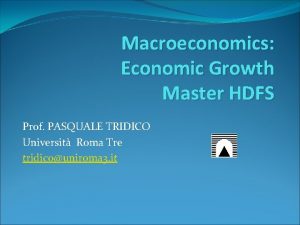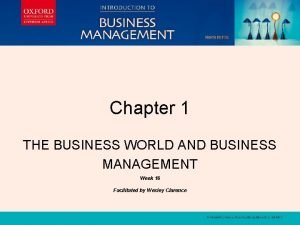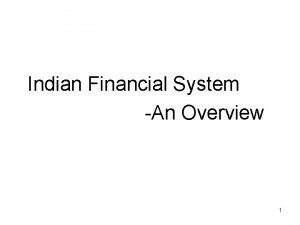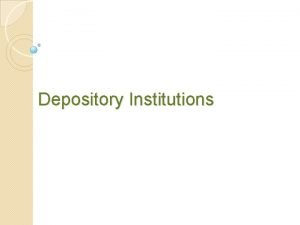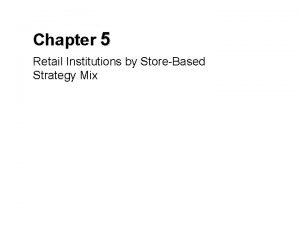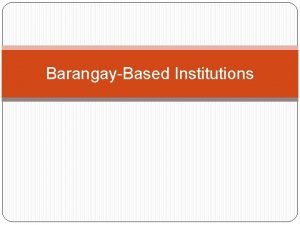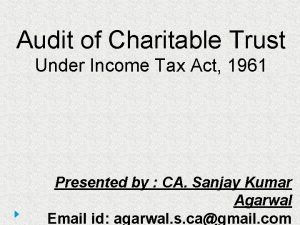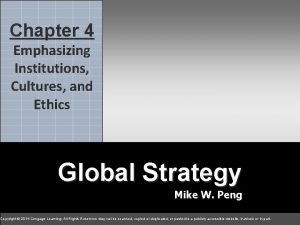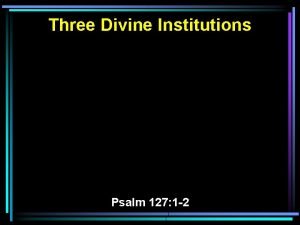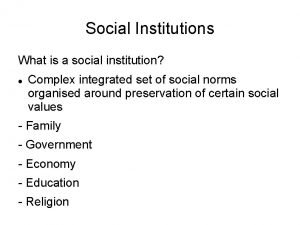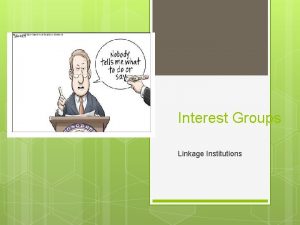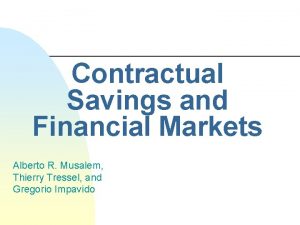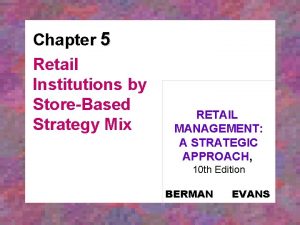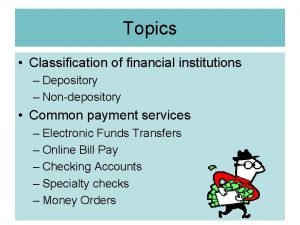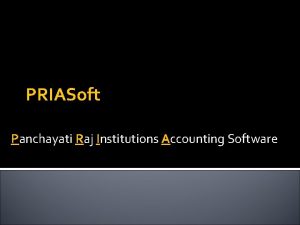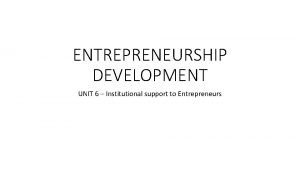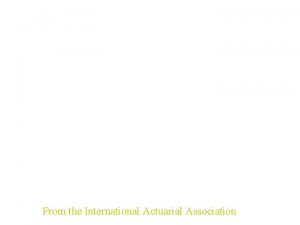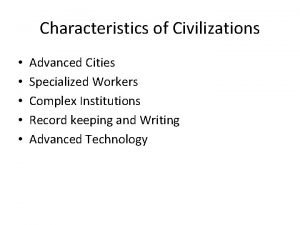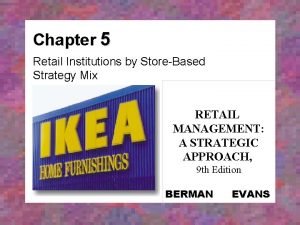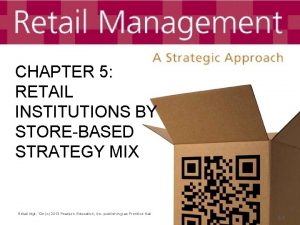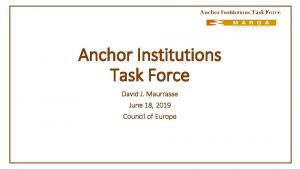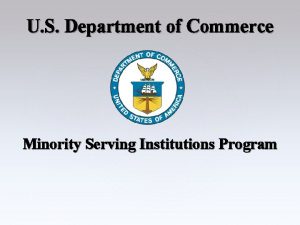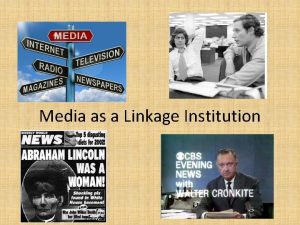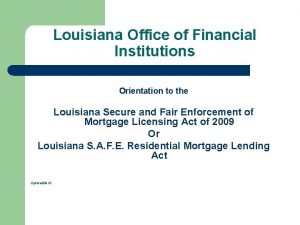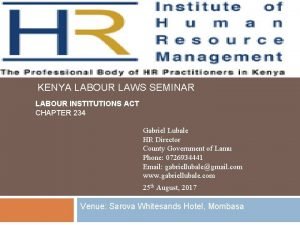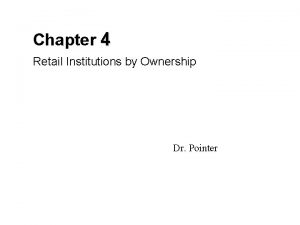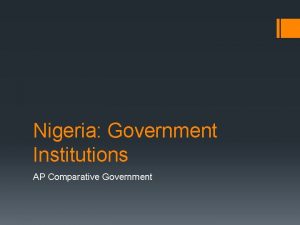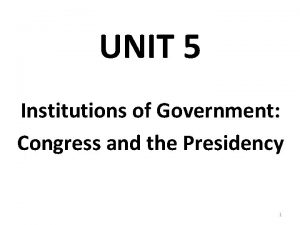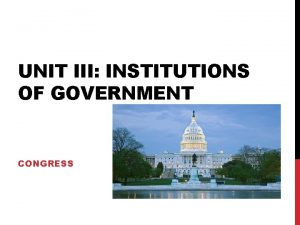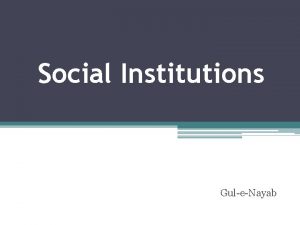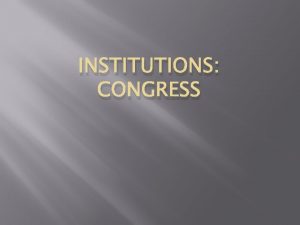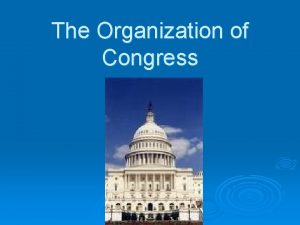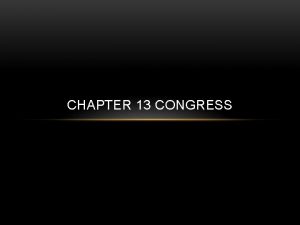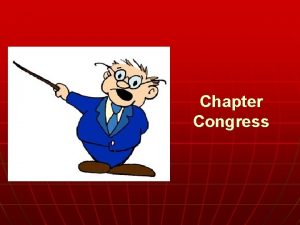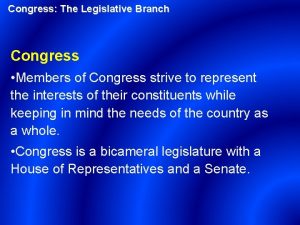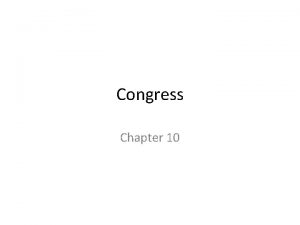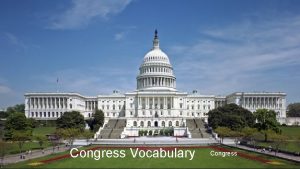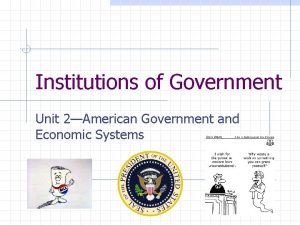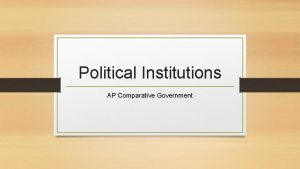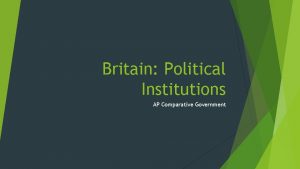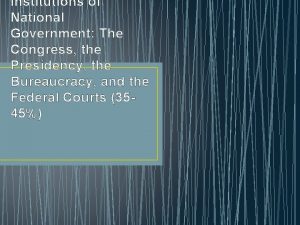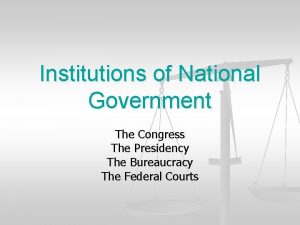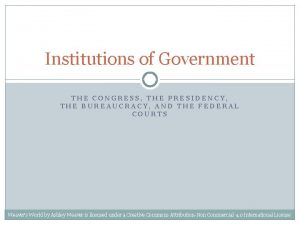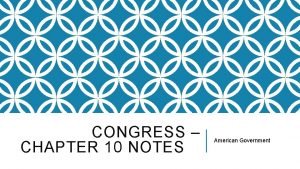UNIT 5 Institutions of Government Congress and the























































































































- Slides: 119

UNIT 5 Institutions of Government: Congress and the Presidency 1

PAY ATTENTION 2

LESSON 27 312 -320 (10. 1) Congressional Elections 3

INTENTIONS OF FOUNDERS • Fear of excessive power concentrated in single institution • Fear of mob rule by impassioned majority • Concern about manner of representation in Congress • Belief that Congress would be the dominant branch of government • Solution: bicameral legislature – Mob rule concern addressed by creation of "upper house" in which senators would be elected by state legislatures rather than the people, and which would check the passions of the people's representatives in the House. – Representation concern settled by a Senate w/equal representation and a House with representation based upon population. 4

OVERVIEW OF CONGRESS: TERMS AND SESSIONS • Term of Congress lasts two years • Terms begin on Jan. 3 of every odd-numbered year • Terms numbered consecutively (113 th Congress from 2013 -2015, 114 th from 2015 -2017) • Adjournment: End of a term; date must be agreed upon by both houses. Two regular sessions per term. Periodic recesses (not to be confused w/adjournment). 5

BICAMERALISM = TWO-HOUSE LEGISLATURE • House of Rep’s was designed to be closer to the people/more responsive to the people: – Members elected directly by the people (rather than indirectly elected, as were Senators until 1913) – Members are elected from smaller districts rather than on an at large basis, like the Senate – Members elected for only a two-year term – Entire body elected every two years – Revenue bills (tax bills) must originate in the House • Senate was designed to be more removed from the people: – Members originally were indirectly elected by state legislatures (until the 17 th amendment) – Members elected on an at-large basis by the entire state – Members elected for a six year term – Only 1/3 of Senate is up for reelection every two years – more stability/continuity (staggered terms) 6

BICAMERALISM = TWO-HOUSE LEGISLATURE • Purpose of bicameralism – To protect against an overly powerful legislature – House of Reps was expected to reflect popular will of average citizen – Senate was to provide more stability, continuity, and in-depth deliberation – Acts as a moderating effect on partisanship, and prevents government from steamrolling ahead and infringing on people’s rights – Part of the Connecticut (Great) Compromise at the Const. Convention • Consequences of a bicameral legislature – Gridlock – designed to be slowed down – Compromise between houses (especially if controlled by different parties) – Additional check and balance 7

HOUSE OF REPRESENTATIVES - SIZE • Determined by Congress - 435 since 1911. • Members elected by districts, not states. • Number of reps per state is determined by population. • Demographic trends show increase in Sun Belt state representation (e. g. , 53 reps in CA, 36 in TX), decrease in Frost Belt representation. 8

HOUSE OF REPRESENTATIVES • Terms of office are fixed – Two years. Entire body up for reelection every two years - A more "responsive" (and potentially "radical") body to be kept in check by the Senate. – Term limits passed by some states, but ruled unconstitutional by Supreme Court (US Term Limits v. Thornton, 1995). • Qualifications – 25 years of age – Citizenship for 7 years – Residency in state 9

SENATE - SIZE • 100 members, chosen in statewide elections (“at large”). With a smaller size, the Senate has been a more informal body with less need than the House for as many strict procedures. • Two members from every state – established in Constitution. 10

SENATE • Terms of office – Six years. 1/3 up for reelection every two years – Staggering of terms ensures a more stable body – No term limits allowed here, either • Qualifications – 30 years of age – Citizenship for 9 years – Residency in state 11

CONGRESS: COMPENSATION • Members set own salaries. 27 th Amendment prevents salary raises from taking effect until the following term. • Many other perks: staff, travel allowance, office space, franking privilege, insurance, etc. 12

CONGRESS: MEMBERSHIP • Over-representation of white, male, Protestant, uppermiddle class lawyers in their 50's ---> charges of conservative/status quo bias. • Rebuttals: – Many more women and minorities have been elected in recent years. – Perfectly possible for white, male, Protestant, upper-middle class lawyers in their 50's to represent the poor and afflicted. – In any case, the people themselves are the ones who elected members. 13

CONGRESS: THE INCUMBENCY ADVANTAGE • Reelection rate in House: >90% (96% in 2008) • Reelection rate in Senate: >80% (90% in 2008) • Relatively few seats are seriously contested in the House. Most are “safe seats. ” • Charges of a “Permanent Congress. ” • The counter to the “Permanent Congress” argument is that reelection rates take into account only those incumbents who run for reelection. Retirements open up quite a few seats each year to new members. 14

ADVANTAGES OF INCUMBENCY • Franking privilege • Staffers • Patronage – one of the key inducements use by political machines. It is a job, promotion, or contract that is given for political reasons rather than for merit or competence alone. • Name recognition • Casework (constituency service) – legislative work on behalf of individual constituents to solve their problems with government agencies and programs • Money, esp. from PACs 15

INCUMBENCY ADVANTAGE: GERRYMANDERING • Number of Rep's per state is determined by population • Census conducted every 10 years – Census will show population changes in states – These changes must be reflected in state representation in House • If a state gains significantly in population, it will probably gain some seats • If a state loses population or does not gain as much as other states, it will probably lose some seats 16

GERRYMANDERING • If a state has a change in the number of seats OR if the population has significantly changed within the state, its district boundaries must change. • This is known as REDISTRICTING, and is usually carried out by the party in power of the state legislature. • A form of redistricting is gerrymandering: redrawing boundaries to favor the party in power of the state legislature. • Origin of the term – From 19 th century Mass. governor Elbridge Gerry, who drew district lines himself. – Some of his districts had such strange shapes that they looked like salamanders, prompting one wag to instead refer to them as "gerrymanders. " 17

GERRYMANDERING • The party in power can get a majority of seats in the House by: – "Packing: " drawing the district lines in such a way as to concentrate the opposing party in a few districts, thus preserving a majority of seats for itself. – "Cracking: " drawing the district lines in such a way as to disperse the opposing party throughout the state and thus dilute that party's strength in order to preserve a majority of seats for the majority party. • Effects – The party in power STAYS in power – "Safe" seats are created for incumbents, leading to further difficulties for challengers – Communities of interest may be broken up – Strangely-shaped districts – "Majority-minority" districts created by racial gerrymandering 18

GERRYMANDERING: EFFECTS “Packing and Cracking” 19

REDISTRICTING • REQUIREMENTS – District lines must be contiguous – Racial gerrymandering is prohibited (Shaw v. Reno, 1993). Race may not be the primary factor in drawing district lines (but it can be a factor). – Cannot dilute racial minority voting strength – “Communities of interest” may be kept intact • SUPREME COURT REDISTRICTING REQUIREMENTS – Districts must be as near equal in population as possible. • Baker v. Carr, 1962: "one man, one vote" principle applied to state legislative districts to correct overrepresentation (malapportionment) of rural areas. • Wesberry v. Sanders, 1964: applied same principle to House districts. • Even if the number of rep’s to which a state is entitled does not change, it redistricts anyway because of geographic shifts in population that may have occurred within the previous ten years. This solves the problem of malapportionment. 20

FREE RESPONSE QUESTION Congressional reapportionment and redistricting are conducted every ten years. When redistricting is conducted, politicians often engage in gerrymandering. a) Define congressional reapportionment and explain one reason why it is important to states. b) Define congressional redistricting. c) Explain two goals of politicians when they gerrymander during redistricting. d) Describe two limits that the United States Supreme Court has placed on congressional redistricting. 21

FREE RESPONSE RUBRIC Part (a): 2 points - One point is earned for a correct definition of congressional reapportionment. One point is earned for a correct explanation of why reapportionment is important to states. An acceptable definition of congressional reapportionment is: • The reallocation of the number of representatives each state has in the House of Representatives. Acceptable explanations of why congressional reapportionment is important to states are: • Reapportionment increases or decreases the number of seats a state has in the House/Congress (not the Senate). • More representatives mean that a state has more influence. • Reapportionment increases or decreases a state’s number of electoral votes. NOTE: The explanation point must be tied to an appropriate definition of reapportionment. Part (b): 1 point - One point is earned for a correct definition of congressional redistricting. An acceptable definition is: • The drawing/redrawing of House/congressional (not Senate) district lines. Part (c): 2 points - One point is earned for each of two explanations of the goals of politicians when they gerrymander during redistricting. Acceptable explanations may include: • To enhance political party strength/to minimize the strength of the opposition party. • To protect incumbents/to discourage challengers. • To increase minority representation/to decrease minority representation. • To punish foes/to reward friends. NOTE: “Cracking” or “packing” must be tied to one of the above in order to earn the explanation point. Part (d): 2 points - One point is earned for each of two descriptions of limits that the United States Supreme Court has placed on congressional redistricting. Acceptable descriptions may include: • Districts must be equally populated. • Lines must be contiguous or connected. • Redistricting cannot dilute minority voting strength. • District lines cannot be drawn solely based upon race. • Districts must be compact. • Communities of interest must be protected. 22

LESSON 28 320 -328 (10. 2) The Structure and Powers of Congress – (10. 3) Congressional Leadership and Committees 23

POWERS OF CONGRESS • EXPRESSED (enumerated, delegated): spelled out in the Constitution – – – – Levy taxes (revenue bills must begin in House) Spend money for common defense and public welfare Borrow money Regulate foreign, INTERSTATE, Indian commerce. This clause has been tested frequently in the courts due to its broad interpretation by Congress. Establish naturalization and bankruptcy laws Coin money Establish weights and measures Punish counterfeiters Establish post offices Grant copyrights and patents Create courts inferior to Supreme Court Define and punish piracy Declare war Raise and support an army and navy 24

POWERS OF CONGRESS IMPLIED POWERS - Powers suggested, but not expressed, in the POWERS - Constitution • • Based upon elastic clause (necessary and proper clause) Must come from expressed power Examples: national bank, conscription, paper money, air force, CIA Strict v. loose constructionist approaches INHERENT POWERS - Powers the national government has simply POWERS - by virtue of being a sovereign govt. • Examples: – regulating immigration – acquiring territory – granting diplomatic recognition 25

INSTITUTIONAL POWERS (THOSE THAT RELATE TO SYSTEM OF CHECKS AND BALANCES) • Senate ratifies treaties with 2/3 vote • Senate approves presidential appointments with majority vote • House votes for impeachment (majority vote needed), Senate tries impeachment cases (2/3 vote needed to convict). Pres, VP, and “all civil officers of the United cases (2/3 vote needed to convict). States” are subject to impeachment • House elects President if no electoral majority • Senate elects V. P. if no electoral majority • Proposal of constitutional amendments with 2/3 vote in both houses 26

FREE RESPONSE QUESTION The framers of the United States Constitution created a legislative system that is bicameral. However, it is not just bicameral; the framers also established two houses of distinctly different character and authority. a) Discuss two reasons why the framers created a bicameral legislature. b) Identify one power unique to the House of Representatives and explain why the framers gave the House that power. c) Identify one power unique to the Senate and explain why the framers gave the Senate that power. 27

FREE RESPONSE RUBRIC Part (a): 2 points • Compromise at Constitutional Convention (representation of large vs. small population states) • Compromise among competing interests / protect minority interests • Slow the process • Different types of representation / federalism • An intra-branch check / prevent majority tyranny Part (b): 2 points - 1 point for identification, 1 point for explanation (linked to character of House) Identifications: • Initiate revenue bills • Choose president when electoral college is deadlocked • Impeachment Explanations: • Closer to the people • More representative of / responsive to public direct election to two-year terms Part (c): 2 points – 1 point for identification, 1 point for explanation (linked to character of Senate) Identifications: • Treaty ratification • Confirmation of judicial and executive appointments • Try impeachments/conviction/removal Explanations: • More mature / "august" body • More insulated from public opinion / indirectly elected (originally) • Longer and/or staggered terms • Reflects state interests Note: • The unique power must be in the Constitution (e. g. , "filibuster" does not get credit because it's a Senate rule, not a constitutional power). 28

FREE RESPONSE QUESTION The United States Constitution established a bicameral legislature with two distinct chambers. a) Identify three differences between the House and Senate that contributes to legislation passing in only one chamber, despite unified party control. Explain how each of these differences accounts for legislation passing in only one chamber, even when the same party controls both chambers. 29

FREE RESPONSE RUBRIC Part (a): 6 points • One point is earned for each correct identification of one difference between the House and Senate that contributes to legislation passing in only one chamber, despite unified party control. • One point is earned for each correct explanation of how this difference accounts for legislation passing in only one chamber, even when the same party controls both chambers. Acceptable identifications of differences between the House and Senate that contributes to legislation passing in only one chamber include: – House is more formal/Senate is less formal or more collegial – Greater workload in the Senate slows the flow of legislation – Harder to get a majority in House – Senate members are less frequently preoccupied than House members about reelection – Filibuster – House Rules Committee – Unanimous consent or Holds – Different constituencies – Powers of presiding officers/speakers – Germaneness of Riders – Greater specialization in the House For each part, the student must explain how the difference identified accounts for legislation passing in only one chamber, even when the party controls both chambers. 30

POWERS DENIED TO CONGRESS • Passing ex post facto laws • Passing bills of attainder • Suspending habeas corpus except in cases of rebellion or invasion 31

HOUSE OF REPRESENTATIVES SPEAKER OF THE HOUSE • Presides over House (Most powerful member) – always from majority party • Appoints select and conference committees • Appoints Rules Committee members and its chairman • Assigns bills to committees • Third in line for presidency after V. P. • Informal powers, e. g. , access to media • Influences agenda of the House MAJORITY LEADER/MINORITY LEADER • Partisan positions chosen by party members • Floor leaders and legislative strategists MAJORITY WHIP/MINORITY WHIP • Assistant floor leaders • Inform party leaders on "mood" of House • Keep nose count on important votes • Persuade party members to vote with party • Liaison between party leadership and rank and file membership 32

THE SENATE PRESIDENT OF THE SENATE • • Vice President of the U. S. Presides over Senate Votes in case of ties Ceremonial job PRESIDENT PRO TEMPORE • • • Ceremonial job Presides in absence of V. P. Fourth in line for presidency MAJORITY LEADER • • • True leader in Senate Recognized first for all debates – w/power to filibuster, this gives Majority Leader strong influence on bills True leader of majority party Influences committee assignments of senators Influences Senate agenda, along with Minority Leader Informal powers, e. g. , of using the media MINORITY LEADER AND PARTY WHIPS • Same as House 33

THE COMMITTEE SYSTEM • Real work of Cong. is done in committees and subcommittees, not on the floor of the House or Senate. • Before a bill even reaches the floor, it must first pass through a committee, unless the committee has resisted "reporting out" the bill and the House votes to "discharge" it onto the floor for consideration by the full body. (Senate committees lack the power to prevent bills from reaching the floor). • Committee functions: 1. 2. 3. Analyze legislation Conduct investigations of executive branch on as-needed basis Conduct oversight of executive branch agencies on an ongoing basis 34

SELECTION OF COMMITTEE MEMBERS • Importance of getting on the right committee, i. e. , one in which a member can best serve his constituents, and thus increase his/her chances of reelection. • Members are assigned to committees by either the Committee on Committees or the Steering the Policy Committee. • Whichever party has majority in the house will have a majority on each committee. • Committee chairman is of majority party; “ranking member” is most senior member of minority party on a committee 35

SELECTION OF COMMITTEE CHAIRMEN • Power of chairmen is substantial over: – – Setting committee agenda Hiring staff Membership on subcommittees Jurisdiction of subcommittees • Chairmen are selected by secret ballot in party caucuses or conferences (of party leaders) at the beginning of the term. – Generally, the seniority system is followed, i. e. , the person of the majority party with the most seniority on THAT COMMITTEE is chosen chairman. 36

SELECTION OF COMMITTEE CHAIRMEN • Advantages of seniority system: – – Experience. Stability. Expertise. Reduces infighting among those who would be rivals for chairmen. • Disadvantages of seniority system: Increases influence of 1 party states, and decreases influence of competitive states. 37

DECENTRALIZATION OF THE 1970'S • Criticisms of the committee system before these reforms – Domineering chairmen – Less senior members are given little power and authority – Committees did their work behind closed doors • Reforms of the 1970's stimulated by the “class of ‘ 74” – – – – – Attack on the seniority system and removal of some chairmen from their positions Chairmen elected by secret ballot Chairmen shared more power and authority Power of subcommittee chairmen increased, and the influence of committee chairmen decreased Number of subcommittees increased More autonomy and power for subcommittees More subcommittee chairs for junior members No member could chair more than one standing committee In Senate, junior senators received staff assistance In House, all members received membership on at least one major committee 38

IMPORTANT STANDING COMMITTEES Standing committees are the permanent committees of Congress. • HOUSE – Rules: Most powerful of all. • Sets legislative calendar and establish “rules” for debate and amendments. – Ways and Means: deals with tax bills. – Appropriations: deals with spending bills. • Authorization bill allows for money to be spent. • Appropriation bill provides the actual funding for the program. • “Earmarks: ” special projects set aside by members to benefit home districts or states. Dramatic rise of these in recent years. – Budget – Armed Services 39

IMPORTANT STANDING COMMITTEES Standing committees are the permanent committees of Congress. • SENATE – – Finance: deals with tax bills. Appropriations: deals with spending bills. Budget. Foreign Relations: Highly prestigious. • Senate has larger role in foreign affairs than House because of treaty ratification, ambassador confirmation provisions in Constitution – Judiciary: Screens judicial nominees. • Careful scrutiny given because of the power of the modern judiciary and the fact that judges have life terms. Presidents Clinton and Bush 43 both criticized the committee by holding up numerous judicial nominations. Some delays under Clinton lasted many months, and in some cases, years. 40

CONFERENCE COMMITTEES • Temporary committees comprised of members from both houses. • Develop compromise language on a bill when House and Senate versions differ (about 10% of the time). • After conference committee sends bill back to each house, no amendments are allowed, and the bill generally passes. • The power of these committees is such that they are often called the "third house of Congress. " 41

OTHER TYPES OF COMMITTEES • SELECT: appointed by a house for a limited, temporary purpose, e. g. , to study an issue or to conduct an investigation. • JOINT: composed of members from both houses for similar temporary purposes. 42

FREE RESPONSE QUESTION Both party leadership and committees in Congress play key roles in the legislative process. a) Define two of the following elements of the congressional committee system and explain how each influences the legislative process. • Specialization • Reciprocity/logrolling • Party representation on committees b) Identify two ways party leadership in Congress can influence the legislative process, and explain how each way influences the process. 43

FREE RESPONSE RUBRIC Part (a): 4 points - 1 point for each of two definitions, 1 point for each of two explanations Committees: Explanations must go beyond merely linking to definition. All explanations must be clearly in context of defined element to get credit. • Specialization [members of Congress develop policy expertise] - development of expertise; independence from executive branch; more attention paid to legislation; division of labor; better legislation accepted only if fully explain HOW. • Reciprocity/ logrolling [vote trading/ exchanges, bargaining] - speeds process, government more expansive (do more). Explanations related to electoral success NOT accepted. More pork barrel ok only if clearly in context of reciprocity. • Party representation on committees [representation is reflective of the chamber as a whole] – party pushes own agenda, determines leadership on committees. Part (b): 4 points - 1 point for each of two identifications, 1 point for each of two explanations Party leadership: Acceptable identification may include: • assignment of members to committees • assignment of committee chairs • scheduling • agenda-setting (rules committee) • party discipline • leadership use of media • recognition on floor • leadership control of electoral support Explanation must specifically indicate HOW the party leadership influences the legislative process. 44

LESSON 29 329 -340 (10. 4) How a Bill Becomes a Law – (10. 6) An Assessment of Congress 45

HOW A BILL BECOMES LAW BILL INTRODUCTION • Less than 10% actually pass • Most originate in the executive branch • Bills can be introduced in either house, except for revenue bills (House only) • Diffusion of power evident in this process: proponents need many victories, but opponents need only one. This was the intent of the Founders: to create a cautious and deliberate process. • Two-step legislative process: 1. Authorization allows for a program 2. Appropriation provides money for that program • Passage of a bill requires only a simple majority 46

HOW A BILL BECOMES LAW COMMITTEE AND SUBCOMMITTEE ACTION • Importance of "correct" committee getting a bill • Committee actions – Pass. Bill is “reported out” to full house for consideration – Kill – Amend ("markup session"). Earmarks are placed at committee level by individual members – Pigeonhole: postponed indefinitely; most frequent fate of a bill 47

HOW A BILL BECOMES LAW COMMITTEE AND SUBCOMMITTEE ACTION • Discharge petition (in the House of Reps) can be used when a bill is bottled up in committee. – Means of bringing a bill out of committee and to the floor for consideration without a report from the committee. • Usually without cooperation of the leadership by "discharging" the committee from further consideration of a bill or resolution. • Requires simple majority of the House • Rarely ever used • Importance of Rules Committee (House only) – “Traffic cop” function – Issues open rule that allows amendments to a bill or closed rule that prohibits such amendments (esp. on tax bills) – Establishes rules on floor debate 48

HOW A BILL BECOMES LAW FLOOR ACTION • Only the Senate can filibuster. – Nonstop debate to kill a bill – A threat of a filibuster is almost as good as a filibuster itself – it places pressure on bill’s sponsors to change parts of the bill – Especially effective at the end of a term – Can be ended by 3/5 vote of cloture • Only the Senate allows non-germane amendments (“riders”). “Christmas tree” bills can result. 49

HOW A BILL BECOMES LAW FLOOR ACTION • Only the Senate uses “unanimous consent agreement” – Majority and minority leaders (in advance) set the details of how it will consider a bill • How long it will debate each amendment • Whether all amendments must be germane (relevant) to the bill's subject matter • When the final vote will be taken – Sometimes whole bills are adopted by unanimous consent, if members are able to agree in advance to all of the bill's provisions. – Help the leadership move noncontroversial matters quickly through the Senate. – A single senator's objection can stop a unanimous consent agreement, giving the minority another chance to stop or delay the majority from acting. 50

HOW A BILL BECOMES LAW FLOOR ACTION • Only the Senate allows any member to place a HOLD on a bill or presidential nomination. – Not in the Constitution, but another example of a Senate tradition. In the past, this was a temporary delay so that, for example: 1) 2) a senator could have more time to consider a bill, or a senator who was going to be absent when a bill was considered would request that the bill be delayed until he returned. – To exercise the hold, a senator informs the floor leader that he/she does not want the bill to be considered – the implied threat of a filibuster and the need for “unanimous consent” for the Senate to proceed on business result in the bill/nomination being held up – Holds can be placed anonymously – Use has been expanded in 90 s as a tactic to kill bills and esp. judicial nominations. 51

HOW A BILL BECOMES LAW CONFERENCE COMMITTEE ACTION • Comprised of members from both houses • Temporary conference committee reconciles different House-Senate versions of a bill, and then sends it back to each house for a vote. • Yet another “third house of Congress. ” 52

FREE RESPONSE QUESTION Members of Congress are charged with three primary duties— writing laws, overseeing the implementation of laws, and serving the needs of their constituents. a) Describe the role of each of the following in lawmaking. • Senate filibuster • House Rules Committee • Conference committee b) Explain how casework affects members’ attention to legislation. 53

FREE RESPONSE RUBRIC Part (a): 3 points Describe the role of each of the following in lawmaking (3 points total, 1 point per role): • Senate filibuster allows a senator on the floor to: – Prevent/delay action on a particular bill. – Prevent/delay other business from being conducted. • Rules Committee schedules or manages the flow of legislation on the floor to: – Make it easier or more difficult for a bill to pass. – Make the process more efficient/orderly/manageable. • Conference Committee reconciles differences in House and Senate versions of a bill. Must describe the role in lawmaking explicitly. Part (b): 1 point Explain how casework affects members’ attention to legislation (1 point): • Diverts time, resources, and staff, thus reducing members’ ability to focus on legislation. • Develops awareness of problems, thus focusing more time and resources on related legislation. 54

HOW A BILL BECOMES LAW PRESIDENTIAL ACTION • Sign the bill in full. • Veto the bill in full –> can be overridden by 2/3 vote in each house. – Line Item Veto ruled unconstitutional in Clinton v. New York. • Ignore the bill. – After 10 days of sending the bill to President, the bill automatically becomes law. – If, however, within that ten-day period, Congress adjourns (not recesses), the bill is pocket-vetoed. 55

FREE RESPONSE QUESTION In the United States Congress, the majority party exerts a substantial influence over lawmaking. However, even when one party has a numerical majority in each chamber of the United States Congress, there is no guarantee that legislation supported by that majority party will be passed by both chambers. Rules of each chamber independently influence the likelihood that legislation will pass in that chamber; legislation passed by one chamber is not always passed by the other. a) Describe two advantages the majority party in the United States House of Representatives has in lawmaking, above and beyond the numerical advantage that majority party enjoys in floor voting. b) Describe two differences between House and Senate rules that may make it likely that legislation may pass in one chamber but not in the other. c) Explain how the differences identified in (b) can lead to the passage of a bill in one chamber but not in the other. 56

FREE RESPONSE RUBRIC Part (a): 2 points - One point is earned for each of two descriptions of majority party advantage in the House of Representatives. The description must include three components: • Majority party • Advantage • Factual statement about the advantage Acceptable answers may include: • Holds committee chairs • Controls Rules Committee • Sets the agenda • Controls debate • Chooses Speaker of the House • Holds majority on each committee • Assigns bills to committees Part (b): 2 points - One point is earned for each of two descriptions of rules differences between the House and Senate. Acceptable answers may include: Procedures and rules Filibuster Holds Unanimous consent agreements Germaneness requirement Rules Committee House More formal no no no Senate Less formal yes yes yes no no Part (c): 2 points - One point is earned for each of two explanations of how a rules difference identified in part (b) affects passage of a bill in one chamber as opposed to the other. Acceptable answers may include: • Filibuster — even though the House may pass a bill, the Senate can kill the bill with a filibuster. • Holds — even though the House may pass a bill, the Senate can delay or stop it with a hold. • Unanimous consent agreements — the Senate can ease passage of a bill with unanimous consent agreements, while the House has no such mechanism. • Germaneness — the Senate can add unrelated content that members of the House might find objectionable. • Rules Committee — even though the Senate may pass a bill, the House Rules Committee can hinder passage of that bill in the House. 57

HOW A BILL BECOMES LAW WHAT IS A LINE-ITEM VETO? • Congress gave the president a line item veto in the mid-90 s (veto individual parts of a bill) • Struck down in Clinton v. NY (1998) as a violation of separation of powers – IT IS UNCONSTITUTIONAL • Use of the line item veto would have enabled the president to legislate, a function reserved only for Congress. • (Most governors do have the power of the line item veto) 58

INFLUENCES ON MEMBERS OF CONGRESS • OTHER MEMBERS OF CONGRESS – e. g. , party leaders, committee leaders, state delegations, other members with a similar ideology, other members with similar districts. If a member votes according to these, he is said to engage in organizational voting. • Use of reciprocity among members (exchange of favors) • Use of logrolling among members (exchange of votes) • CONGRESSIONAL STAFF MEMBERS – As society has grown more complex, and Congress has taken on more responsibilities, Congress has needed to add staff to deal with these realities. Staff can: • • • Control information that members receive Control access to members Help to set committee agenda Make recommendations on legislation Help to write legislation Discuss pros/cons of staffers representing an undemocratic aspect of Congress 59

INFLUENCES ON MEMBERS OF CONGRESS • INTEREST GROUPS/LOBBIES/PACS – Influence through: • • • campaign contributions "report cards" targeting providing information testifying before committees • CONGRESSIONAL CAUCUSES – e. g. , black caucus, Hispanic caucus, blue collar caucus, women's caucus • THE PRESIDENT – Can reward or punish members, particularly those within his own party by: • • Campaigning for or against members Attending or not attending members' fund raisers Speaking out for or against members Using his "electronic throne" to gain leverage (“going public”) 60

INFLUENCES ON MEMBERS OF CONGRESS • CAMPAIGN CONTRIBUTORS – Again, the evidence here is mixed. Some studies show that contributions affect voting behavior, but others have downplayed this, citing other influences such as party membership. – If contributions do affect congressional voting, they probably have the greatest effect on narrow issues that are not well known or publicized. • THE MEDIA – e. g. , through its "watchdog" role 61

INFLUENCES ON MEMBERS OF CONGRESS • IRON TRIANGLES – Also known as subgovernments, issue networks, policy networks: a congressional committee, the related federal agency, and the impacted interest groups. – For example, on the issue of airline deregulation, an iron triangle might consist of: • Public Works and Transportation Committee • Federal Aviation Administration (FAA) • Numerous interest groups such as the Air Transport Assn. , mechanics' unions, pilots' unions, etc. • PARTY MEMBERSHIP OF MEMBERS – This seems to be the best predictor of congressional voting – party unity scores are quite strong. Party affiliation is a particularly strong influence on economic and social welfare issues, and less of an influence on foreign policy and civil liberties issues. 62

INFLUENCES ON MEMBERS OF CONGRESS • CONSTITUENT CONVICTIONS – If a member votes according to these, he is said to act in the delegate role and engage in representational voting. • Of course, it is often difficult to gauge constituent opinion on a given issue. • Most constituents are not even aware of the issues faced by Congress. • Another complication is the diversity of interests throughout districts and states. • MEMBERS' OWN CONVICTIONS – If a member votes according to these, he is said to act in the trustee role and engage in attitudinal voting. 63

FREE RESPONSE QUESTION There are several different approaches to representation within a democratic political system. a) Define direct democracy. b) Define republican form of government. c) Describe one reason the framers of the United States Constitution chose a republican form of government over a direct democracy. d) Describe each of the models of congressional representation. • Trustee model (attitudinal view) • Delegate model (representational view) e) Explain why a member of Congress might sometimes act as a trustee (attitudinal view) rather than a delegate (representational view). 64

FREE RESPONSE RUBRIC Part (a): 1 point - One point is earned for a correct definition of direct democracy: • Rule by the people + Individual participation on legislation or policy OR Making decisions without delegating authority to elected representatives Part (b): 1 point - One point is earned for defining a republican form of government: • Authority is delegated to elected representatives to make decision on behalf of citizens. Part (c): 1 point - One point is earned for a description of one reason the framers chose a republican form of government. Reasons include: • Fear of mob rule (tyranny of the majority) • Size of country • Elitism – inadequate education/uninformed public • Did not trust people • To counter the influence of factions • Preexistence of states • Reinforcement of federalism Part (d): 2 points - One point is earned for each description of the models of congressional representation. An acceptable description of the trustee model (attitudinal view): • Decisions made by elected official using their own personal views or decisions made by the elected official based on the public good and not on the basis of constituents’ views. An acceptable description of the delegate model (representational view): • Decisions made by the elected official mirror the constituents’ views, represent constituents’ views, or do what voters tell them to do. Part (e): 1 point One point is earned for an acceptable explanation of why a member of Congress might sometimes act as a trustee (attitudinal view) rather than a delegate (representational view). • Information access • Reliance on expertise • Divided constituency • Salience of issue • Vote his or her conscience (explaining why) • Difficulty determining what voters want Note: Must close loop to show contrast that the representative is voting regardless of what the constituents want. 65

THE CASE AGAINST CONGRESS IS INEFFICIENT • • • Bicameralism Decentralization of Congress has excessively spread out power. So many power centers make it difficult to get things done. Proponents of a bill need many victories, but opponents need only one. Excessive electioneering and fundraising are a drain on members’ time. Partisanship interferes with efficiency CONGRESS IS UNREPRESENTATIVE • • Represents narrow geographical interests at expense of national interest. Public likes their own representatives, but dislike the Congress as a whole. “All politics is local” = members place state and local interests over the national interest in order to get reelected. Criticism that Congress is a club for white, male, middle-aged, Protestant lawyers. Though the seniority system has been modified, the older members still generally get chairmanships. Unequal representation – Alaska, with only a fraction of the population of California, has the same representation as the more populous state in the Senate. An unelected staff Lack of 3 rd party representation 66

THE CASE AGAINST CONGRESS IS UNETHICAL • Numerous scandals • Excessive/unethical fund raising • PAC influence • Junkets: Interest groups or donors contribute money to a non-profit organization, which then pays for trips of members of Congress. These indirect contributions are technically legal, but seem to violate the spirit of the rules against financial wrongdoing Logrolling • • Lobbying by family members of Congress, who may not be subject to the same ethical restrictions as members of Congress themselves. • Corporate hiring of family members of Congress • Lobbying of Congress by former members of Congress 67

THE CASE AGAINST CONGRESS IS IRRESPONSIBLE • Diffusion of power allows members to be absolved of any individual responsibility. Thus, we find the curious paradox of the American people liking their own individual members of Congress, but distrusting the body as a whole. • Diffusion of power allows a "watering down" of bills when opponents throw so many obstacles at a bill that proponents simply have to give in and compromise to get anything at all. • “Spending bias” of Congress. Members are more likely to receive voter approval for projects in their districts than they are for cutting federal spending -> a natural instinct for spending rather than cutting spending. “Earmarks” are consistent w/this charge against Congress. 68

LESSON 30 344 -357 (11. 1) The Structure and Powers of the Presidency 69

DELIBERATIONS AT THE CONSTITUTIONAL CONVENTION ALTERNATIVES • • Some proposed a plural executive Some wanted an executive council to have veto power over presidential actions Some (e. g. , Alexander Hamilton) wanted a President with a life term Eventually, compromises brought about a single, elected President with a fixed term of office CONCERNS OF THE FOUNDERS • • • Fear of an excessively strong President – Fear that the presidency would be the "fetus of monarchy" – Concern over no term limits (no 22 nd Amendment until 1951) Fear of an excessively weak President who would become a "tool of the Senate" because of its ratification and confirmation powers. The basic problem of creating a presidency: – Make him too weak: the legislature will usurp his powers. – Make him too strong: he will usurp the legislature. 70

ELECTION OF THE PRESIDENT Some wanted Congress to elect the President ---> fear of congressional dominance. Some wanted direct election. Problems: • • Inordinate weight to large states Demagogues might have excessive appeal to the masses Illiteracy was common Communication was poor THE COMPROMISE: THE ELECTORAL COLLEGE • • • The people had some input Large states had a good amount of influence, but small states were protected by having a minimum of three electoral votes Small states would also have a great deal of clout if the election were thrown into the House (and it was assumed that this would happen often since the two party system was not anticipated). Under this scenario, a state has one vote and small states are therefore grossly overweighted. 71

ELECTION OF THE PRESIDENT TERM OF OFFICE • Four-year term • Fear of an unlimited number of terms of office were quieted when Washington chose not to run for a third term • Precedent was followed until 1940 (FDR) -> creation of 22 nd amendment QUALIFICATIONS • Natural-born citizen • At least 35 years of age • Residency for at least 14 years SELECTION • Elected in November in years divisible by 4 • People >> Electors >> President • Electoral votes counted on January 6 • President inaugurated on January 20 (established by the 20 th amendment) 72

TERM OF OFFICE • Four years • Maximum of two elected terms – Amendment 22 institutionalized Washington’s precedent. – Passage of 22 nd Amendment (1951) was due to the Republican congress’ concern over future FDR’s. – Possible to serve just less than 10 years in office if a V. P. becomes President just after the midpoint of a President’s term of office. • If a V. P. serves less than half of a President’s term, he can be elected to the presidency twice. • If a V. P. serves more than half of a President’s term, he can be elected to the presidency only once. – Lyndon Johnson succeeded JFK in 1963, and was therefore eligible to be elected twice. – Gerald Ford succeeded Nixon in 1974, and was therefore eligible to be elected only once. 73

SUCCESSION If office of presidency is vacant due to death, resignation, or impeachment and removal, the V. P. becomes President. • He in turn nominates, and Congress confirms, a new VP. If V. P. dies before his inauguration as President, the line of succession is as follows: • • • Speaker, Senate President Pro Tem, Sec. of State, Sec. of Treasury, Sec. of Defense, and then the other Cabinet secretaries in the order of the creation of their offices. (Presidential Succession Act of 1947) If the President is disabled, the 25 th Amendment applies: • • • The President informs the Congress of disability and the V. P. becomes Acting President. If the President is unable to inform Congress (e. g. , coma), the V. P. and a majority of Cabinet secretaries can go to the Congress and receive approval for the V. P. to become Acting President. In either case, the President regains powers by informing the Congress of his intent to return. In case of dispute, Congress has the power to decide who shall be President. 74

NON-CONSTITUTIONAL SOURCES OF PRESIDENTIAL POWER Unity of the office: the office is held by one man, as opposed to the 535 -member Congress. Presidential character and personality: Strong personalities such as the Roosevelt’s and LBJ can have great impact. Growing complexity of society: With a highly industrial and technological society, people have demanded that the federal government play a larger role in areas of public concern, e. g. , pollution , labor issues, air travel safety. The executive branch has thus grown to meet those public demands. Congressional delegation of authority to the executive branch. • Congress often writes broadly worded legislation and lets executive agencies “fill in the holes. ” • Congress often bows to presidential demands in time of economic or foreign crisis. • Congress often bows to the President when he can proclaim a mandate from the people after a large electoral victory, e. g. , Reagan insisting upon tax cuts and higher defense spending after the 1980 election. Development of the mass media casts the President into the public eye -> use of TV as the “electronic throne. ” • Special addresses, press conferences, Saturday morning radio chats, photo opportunities, sound bites, staged events, “going public. ” Emergence of the U. S. as the great superpower after WWII. • Development of the Cold War placed the U. S. into a virtual non-stop crisis situation after 1945 -> assumption of great powers by the President to deal with various foreign crises. 75

ROLES OF THE PRESIDENT CONSTITUTIONAL ROLES CHIEF LEGISLATOR • Powers – Proposes legislation. – Vetoes legislation (but lacks line item veto struck down by Supreme Court because of conflict with separation of powers). – Calls special sessions of Congress. – Makes a State of the Union Address to Congress. • Checks – Congress need not pass suggested legislation. – Congress can override veto with 2/3 majority in both houses. 76

ROLES OF THE PRESIDENT CONSTITUTIONAL ROLES CHIEF EXECUTIVE • Powers – “Take care” clause of Article II requires that President enforces laws, treaties, and court decisions. This clause has also been used to justify: • Impoundment • Lincoln’s suspension of habeas corpus • Electronic eavesdropping by Bush 43 administration – Appoints officials to office, and can fire them. – Issues executive orders (which have the force of laws) to carry out laws. These do not need congressional approval. • • FDR issue an executive order to intern Japanese-Americans during WW II • LBJ's executive order #11246 that required affirmative action programs for federal contractors. • Bush 43 created Office of Homeland Security after 9 -11 through an executive order. (Later made a Cabinet Dept. ) Checks – Congress passes the laws and has the "power of the purse. “ – Senate can reject appointments and treaties. – Impeachment (by House) and removal (by Senate). – Supreme Court can strike down executive orders. 77

ROLES OF THE PRESIDENT CONSTITUTIONAL ROLES COMMANDER IN CHIEF • Power – Head of the armed forces (link w/civilian supremacy) CHIEF DIPLOMAT • Powers – Sets overall foreign policy. – Appoints and receives ambassadors. • Checks – Congress appropriates funds for the military – Congress declares war – War Powers Act of 1973 – Negotiates both treaties and executive agreements. – Gives diplomatic recognition to foreign governments. • Checks – Congress appropriates funds foreign affairs. – Senate can reject ambassadors and treaties. 78

ROLES OF THE PRESIDENT CONSTITUTIONAL ROLES CHIEF OF STATE • The ceremonial head of our nation, e. g. , tosses out the first ball of the baseball season, bestows the medal of honor, visits areas struck by natural disaster. • Most nations separate the Chief Executive and Chief of State roles (e. g. , Britain has a prime minister and a monarch, respectively), but the office of the presidency combines both of these roles. CHIEF JURIST • Powers – Appoints federal judges. – Issues pardons (e. g. , Ford pardoned Nixon for Watergate) and amnesty. • Checks – Senate can reject judicial appointments. – Senators can place “holds” on appointments. – Senators can filibuster nominations. 79

FREE RESPONSE QUESTION Presidents are generally thought to have advantages over Congress in conducting foreign policy because of the formal and informal powers of the presidency. a) Identify two formal constitutional powers of the president in making foreign policy. b) Identify two formal constitutional powers of Congress in making foreign policy. c) Identify two informal powers of the president that contribute to the president’s advantage over Congress in conducting foreign policy. d) Explain how each of the informal powers identified in (c) contributes to the president’s advantage over Congress in conducting foreign policy. 80

FREE RESPONSE RUBRIC Part a: (2 points) 1 point for each of two identifications Acceptable identifications of explicit, formal constitutional powers of the President may include: • Commander-in-chief; power to commit troops • Appointment of ambassadors and foreign policy officials • Negotiate/make treaties • Recognition of nations • Receive ambassadors and other public ministers Part b: (2 points) 1 point for each of two identifications Acceptable identifications of explicit, formal constitutional powers of Congress may include: • confirm ambassadors • power of purse in military/foreign policy matters • declare war • pass laws/resolutions re: foreign policy issues • regulate foreign commerce (including trade agreements) • ratify treaties Part c: (2 points) 1 point for each of two identifications Acceptable identifications of informal powers may include: • executive agreements • access to media/bully pulpit/morale building • agenda setting • meet with world leaders • crisis managers • international coalition building • President has access to more information, knowledge, or expertise than does Congress • Recognized as global leader Part d: (2 points) 1 point for each of two explanations Response must show or why the identified power gives the President advantages over Congress. Acceptable explanations of the President’s advantage over Congress may include: • Persuade congress; negotiate, offer support, threats, etc. • Persuade public: (various means of persuasion) on foreign policy process/issues (e. g. , apply pressure to Congress) • Ability to circumvent the formal process 81

FREE RESPONSE QUESTION A number of factors enable presidents to exert influence over Congress in the area of domestic policy. However, presidents are also limited in their influence over domestic policymaking in Congress. a) The Constitution grants the president certain enumerated powers. Describe two of these formal powers that enable the president to exert influence over domestic policy. b) Choose two of the following. Define each term and explain how each limits the president’s ability to influence domestic policymaking in Congress. • mandatory spending • party polarization • lame-duck period 82

FREE RESPONSE RUBRIC Part (a): 2 points One point is earned for each of two descriptions of formal, enumerated powers that enable the president to exert influence over domestic policy. Acceptable descriptions may include: • Legislative powers (veto, pocket veto, signing legislation). • State of the Union address. • Appointment power (to a domestic office). • Calling Congress into session. • Chief executive role (“faithfully execute the law” clause). • Commander-in-chief role (must connect it to domestic policy in order to earn the point). Part (b): 4 points One point is earned for each of two definitions and two explanations of limits to the president’s ability to influence domestic policymaking in Congress. Explanations must be tied to a correct, though not necessarily complete, definition. 83

FREE RESPONSE QUESTION The Constitution of the United States creates a government of separate institutions that share power rather than a government that delegates power exclusively to a single branch. Frequently, this means that presidents and Congress struggle with each other. a) For each of the presidential powers below, explain one way that congressional decision making is affected by that power. • Veto power • Power to issue executive orders • Power as commander in chief b) For each of the congressional powers below, explain one way that presidential decision making is affected by that power. • Legislative oversight power • Senate advice and consent power • Budgetary power 84

FREE RESPONSE RUBRIC Part (a): 3 points One point is earned for each explanation of how congressional decision making is affected by the following presidential powers: • Veto power – Results in congressional interaction with the president/executive branch during the legislative process (e. g. , bargaining, negotiation, compromising, consulting). – Prevents or discourages congressional action if the president makes a statement of clear opposition or threatens a veto. • • Power to issue executive orders – Congress acts in response to or anticipates executive orders (e. g. , countermands, preempts, compromises). – Congress avoids taking action on controversial issues. Power as commander in chief – Congress engages in oversight activities. – Congress clarifies its role associated with the power to declare war (i. e. , War Powers Act). – Congress controls military spending and thus can approve, modify or reject funding. Part (b): 3 points One point is earned for each explanation of how presidential decision making is affected by the following congressional powers: • Power of legislative oversight – Presidents minimize the number or extent of actions that might draw congressional scrutiny. • Senate advice and consent power – Presidents weigh the implications of making controversial or ideological nominations or appointments. – Presidents use recess appointments, avoiding controversial confirmation battles. – Presidents use executive agreements to avoid the need to have treaties ratified. • Budgetary power – Presidents consider budget items or programs that are important to members of Congress. – Presidents consult with members of Congress during the budget process. – Presidents sign budgets that include provisions they oppose rather than veto the budget. – Presidents postpone agenda items because of difficulty in getting congressional budgetary approval. 85

ROLES OF THE PRESIDENT NON-CONSTITUTIONAL ROLES HEAD OF POLITICAL PARTY • Selects the party's chairman of the national committee and VP nominee. • Political patronage. CHIEF ECONOMIST • Responsible for the overall health of the economy. • Proposes the federal budget (though Congress can alter it). 86

LESSON 31 357 -361 (11. 2) Controversies in Presidential Power – (11. 3) Managing the Presidency 87

EXECUTIVE OFFICE OF THE PRESIDENT • White House Office/White House Staff – Immediate staff of President – Office space in West Wing of White House –> proximity to President. • Rule of Propinquity: Power is wielded by people who are in the room where decisions are made. – Appointments to the White House Office • • e. g. Chief of Staff, generally do not require Senate consent Officials are less subject to testifying before Congress since they have a greater degree of executive privilege protection. Presidents typically seek people who will be loyal – less divided loyalties are compared to Cabinet positions. OMB (Office of Management and Budget) – Prepares the annual budget and reviews federal programs • NSC (National Security Council) – Coordinates foreign/military policy – Increasing importance of the National Security Adviser since the Nixon presidency • CEA (Council of Economic Advisors) – Three-person advisory group on economic policy 88

CABINET • Definition – The 15 Secretaries and 5 others who hold “Cabinet rank” (OMB Director, CIA Director, White House Counselor, UN Ambassador, US Trade Rep). • Each of these is appointed by the President w/Senate consent. • In parliamentary systems: – Cabinet officials are members of Parliament – The Cabinet meets regularly – The Cabinet collectively hammers out public policy 89

CABINET In our system: • Cabinet officials are constitutionally banned from also being members of Congress. • The Cabinet meets irregularly. Only at the call of the President. • Cabinet officials are more interested in defending/enlarging their own departments than they are in meeting together to hammer out public policy. Many newly-elected Presidents speak of enlarging the Cabinet's role, but then think better of it as time goes on. – A reason for this is the divided loyalties of Cabinet officials: Are the Secretaries most loyal to the President? To the Congress (which funds the departments)? To client groups (which depend upon the departments)? To the employees within the departments (with whom the Secretaries must deal on a daily basis)? – Another reason is that the President’s goals often conflict with Cabinet Dept. goals, e. g. , the President may want to cut spending, but Cabinet Secretaries generally want to see their departments grow rather than shrink. 90

CABINET Presidential influence over the Cabinet is limited: • Presidents can, of course, fire the political appointees within a department. • However, Presidents have little control over the civil service employees of a department. These account for > 90% of all the people who work within the Cabinet departments, and it is exceedingly difficult to fire them from their positions. 91

FACTORS AFFECTING SELECTION OF CABINET SECRETARIES • • • Party affiliation Interest group influence Race Gender Geographical diversity “Confirmability” 92

FEDERAL APPOINTMENTS Who gets appointed to federal positions? • As mentioned, the number of appointments is large, but the percentage of appointed positions in the federal government is small. (Less than 10%). • Presidents often do not know their appointees well -- They depend heavily on staff recommendations. Background of appointees: • Tend to come from private industry, universities, law firms, think tanks, Congress, state/local government. • Most have had some federal experience. • Some have had some federal experience just prior to appointment. • Some are "in-and-outers, " i. e. , people who alternate between jobs in the public sector and private sector -- the "revolving door. " 93

VICE PRESIDENT Only two constitutional duties: • • Become President or Acting President if the office of President is vacant. Preside over the Senate, voting only in case of ties. Traditionally, the V. P. is a dull, do-nothing job The job of a V. P. is basically what the President says it is • • • Often involves unappealing work (e. g. , attending funerals of foreign leaders) V. P. is often selected not on basis of qualifications, but on basis of balancing the ticket. After he has "done his job (i. e. , helped win votes), " the V. P. is often "put out to pasture" for dull work. Importance of the office: • • 9/44 Presidents have not finished their terms of office. V. P. can become Acting President if the President is disabled. In recent years, Presidents (e. g. , Carter, Reagan, Clinton) have made more effective use of the V. P. This is especially true of Bush-Cheney. Vice presidency can be a steppingstone to the presidency, e. g. , Bush 41. 94

POWER OF THE OFFICE OF THE PRESIDENCY • President's powers are not as clearly defined in the Constitution as are Congress‘ powers. Constitution grants broadly-worded powers (e. g. , "executive power") to the President, but does not spell them out very clearly. • In times of emergency, power grows to vast proportions. In times of emergency, the President can assume the powers of a monarch. • In "normal" times, the President has to deal with the system of checks and balances ---> a dilemma: we expect so much of the President, but we place a number of obstacles in his path. • One way of looking at power is to recognize that the powers of the President are great, but so are the problems of the 21 st century. 95

CHECKS THAT WEAKEN THE PRESIDENT • Traditional, constitutional checks: – Congress – Courts • Informal checks: – – – – Congressional leaders Cabinet members Bureaucrats Political parties Interest groups Media: adversarial journalism, “gotcha” journalism Senators’ use of “holds” and filibusters on presidential nominations Divided government 96

FREE RESPONSE QUESTION The concept of "divided government" in the United States means that one political party can control the executive branch while another controls the legislative branch. This poses problems for the President in making appointments to federal offices. a) Describe two problems that divided government poses for the President in making federal appointments. b) Identify and explain two ways Presidents try to overcome the problems described in (a). 97

FREE RESPONSE RUBRIC Part (a): (problems posed for Presidents) - 2 points possible Simple, declarative statements acceptable for description • greater policy conflict likely/ideological conflict • narrows the field of potential candidates • offices go unfilled • tougher committee scrutiny • harder to get congressional/Senate/legislature approval/confirmation/ratification of appointments (House not acceptable) • more frequent character attacks on nominees SENATORIAL COURTESY DOES NOT APPLY Part (b): (ways Presidents overcome problems) - 4 points possible One point for identification; second point for explanation only available after adequate identification. Explanation must answer how Presidents' efforts work to overcome problems. (Reference to approval/ratification/confirmation must include reference to Senate/Congress. Reference to congress or legislature is acceptable; House is NOT) • generate public support (including use of media) • compromise on choices (ideological compromise) • building coalitions in Congress • making deals (e. g. , veto as threat) • building coalitions with interest groups • making interim recess appointments • more intense background screening of nominees (looking for “bulletproof” candidates) • selecting more minority nominees (i. e. , "diversification") • increased reliance on White House staff (when forced to appoint officials not in line with President's position) 98

SUGGESTIONS FOR STRENGTHENING THE PRESIDENCY • Revitalize political parties to make it easier for the President to get things done • Revise constitutional restraints: – 6 -year term of office, w/no reelection – 2 or 3 person presidency – Give the President the power to dissolve Congress and call for new elections – Allow members of Congress to take positions within the executive branch – Provide a unified party ticket of President/Senator/Congressman -- no more split tickets 99

CONGRESS VS. THE PRESIDENT HISTORICAL BACKGROUND • Founders' intent on Congress to be the dominant branch. • In the 20 th century, the President has generally been more dominant. 100

SOURCES OF CONFLICT BETWEEN THE PRESIDENT AND CONGRESS • SEPARATION OF POWERS AND CHECKS AND BALANCES – • • The Constitution is "an invitation to struggle between the President and Congress. " There is supposed to be conflict. EACH REPRESENTS DIFFERENT CONSTITUENCIES: – Members of Congress represent state and local interests ("All politics is local"). – The President, however, represents the national interest. DIFFERENT TIMES OF ELECTION – Difficult for either to gain excessive power for any great length of time • • • Clinton was elected in '92 with a majority of Democrats in Congress, but just two years later the Republicans captured a majority of both houses. PARTISANSHIP – Since 1952, Presidents have often faced a Congress that has had a majority of the opposing party. – Even when the Congress has a majority of the same party as the President, intra-party struggles are common. With the weakening of political parties, the President does not have a strong "hold" on members of his own party in Congress. For example, some congressional Republicans wanted a stricter immigration policy than Bush 43. “TWO PRESIDENCIES” THESIS – Congress tends to be more cooperative with the President on foreign policy and national security issues (esp. in a crisis), but is less cooperative on domestic and economic issues. 101

SOURCES OF PRESIDENTIAL INFLUENCE ON CONGRESS • USE OF MEDIA – – Media focuses more on a single person than on 535 people. President can easily go directly to the people with his case. • "MANDATE FROM THE PEOPLE" after winning election by a large margin. • PATRONAGE – – • CHIEF OF PARTY ROLE – • Use of both favors and punishment for cooperative or uncooperative members. VETO, OR ITS THREAT – • Convincing members of Congress to act in interests of "party unity. " PERSONAL LOBBYING OF MEMBERS OF CONGRESS – • Enables a President to carry out policy his way. Enables a President to cultivate members of Congress by seeking their input on appointments. 93% of vetoes are not overridden, so even the threat of a veto carries weight. PRESENCE OF A NATIONAL EMERGENCY 102

FREE RESPONSE QUESTION Presidential approval ratings fluctuate over the course of each presidential administration. a) Identify two factors that decrease presidential approval ratings, and explain why each factor has that effect. b) Identify two factors that increase presidential approval ratings, and explain why each factor has that effect. 103

FREE RESPONSE RUBRIC 104

LESSON 32 361 -374 (11. 4) The President’s Job – (11. 6) Judging Presidents 105

THE IMPERIAL PRESIDENCY • Throughout much of this century, the President has been the “great engine of democracy. ” • The President was supposed to exercise great power to meet his goals. • In the wake of the Vietnam War and Watergate, however, Congress reasserted itself against what came to be seen as an “Imperial Presidency. ” • The Imperial Presidency suggested that presidential power had grown excessive ("imperial"). • Response: – Economic growth necessitated a strong executive branch. – Congress itself delegated strong powers to the executive branch, esp. in area of foreign policy. 106

THE IMPERIAL PRESIDENCY AREAS OF ABUSE • • WAR POWERS – Constitutional conflict of Congress' power to declare war vs. President's power as Commander-in-Chief. – In the 18 th century, Congress had more time to deliberate war issues; in the modern era, however, Presidents have argued that they need more flexibility to meet rapidly changing conditions. – Presidents have sent troops without a congressional declaration of war more than 125 times. This happened very frequently since 1945. – Congress has in fact generally gone along with these operations, and has of course funded them, as well. When public opinion turns against the operations, however, Congress has often responded (e. g. , Vietnam War). – One of the reasons Congress has gone along with these operations without a formal declaration of war is that such a declaration carries with it the transfer of great emergency powers to the President that the Congress may not want to grant him. EMERGENCY POWERS – In time of war or emergency, the President assumes great powers. • Examples: – Suspension of habeas corpus – Control of communication and transportation – Declaration of martial law – Patriot Act 107

THE IMPERIAL PRESIDENCY AREAS OF ABUSE • USE OF EXECUTIVE AGREEMENTS (RATHER THAN TREATIES) – Definition: Deal between the President and the head of another nation (e. g. , the destroyers-for-bases deal between FDR and Churchill in 1940). • • – • What is particularly galling to Congress is that treaties are often on relatively trivial issues (e. g. , archaeological artifacts in Mexico), but executive agreements are often on matters of great importance (e. g. , military commitments to various nations) EXECUTIVE PRIVILEGE – – • Unlike a treaty, executive agreements do not require Senate ratification. Since WWII, the number of executive agreements has vastly outnumbered the number of treaties. Between 1980 -1991, there were > 4100 executive agreements and less than 200 treaties. Definition: The right of president to NOT divulge conversations between himself and his advisers. Presidents claim that if such conversations were not “privileged, ” advisers would be hesitant to give straightforward advice. Critics claim that Presidents have abused this privilege by claiming it under the guise of “national security. ” In U. S. v. Nixon (1974), the Supreme Court stated that Presidents are in fact entitled to executive privilege most of the time, but not in criminal cases. IMPOUNDMENT – – – Definition: The refusal of the President to spend money that has been appropriated by Congress. In the past, this was done when there was an obvious need, e. g. , reducing defense spending after a war ended. Nixon, however, impounded funds for policy objectives. Some members of Congress were livid that money was not spent when it had been lawfully appropriated by legislation. Such impoundment seemed unconstitutional. 108

CONGRESS RESPONDS TO THE IMPERIAL PRESIDENCY WAR POWERS ACT OF 1973 • President can send troops overseas to an area where hostilities are imminent without a congressional war declaration only under these circumstances: – Must notify Congress within 48 hours – Must withdraw the troops after 60 days (can be extended another 30 days if the safety of the troops requires it) – Must consult w/Congress if troops are to engage in combat – Congress can pass a resolution, not subject to presidential veto, to have the troops withdrawn • Criticisms – Unconstitutional – an abridgement of the President’s authority as Commander in Chief – Ties the hands of the President – too inflexible – Makes it easy on the enemy – just wait 60 -90 days • Presidents have claimed the act to be unconstitutional, some have disregarded it, but there has been no lawsuit to determine its constitutionality. A “political hot potato? ” 109

FREE RESPONSE QUESTION Conflicts between Congress and the President over war powers have their origin in the United States Constitution. In 1973 Congress passed the War Powers Resolution in an attempt to clarify the balance of powers between the two branches of government. a) Describe the primary constitutional conflict between Congress and the President over the decision to go to war. b) Describe two provisions of the War Powers Resolution that were designed to limit the President’s power over war making. c) The War Powers Resolution has received mixed reviews, but Congress has other powers over war making. Other than the constitutional power that you described in (a), identify and explain two other formal powers Congress has over war making. 110

FREE RESPONSE RUBRIC Part (a): 1 point One point is earned for a correct description of the primary conflict over the decision to go to war: the President is commander-in -chief and Congress has power to declare war. Part (b): 2 points One point is earned for each correct description of a provision of the War Powers Resolution designed to limit the President’s power over war making. Acceptable descriptions include: • President must notify Congress within 48 hours of sending troops into combat. • President must consult with Congress whenever feasible. • Conflicts are limited to 60 days unless Congress takes action, • Congress can extend time from the initial 60 days or can withdraw troops after 60 days with adequate notification to the President. Part (c): 4 points One point is earned for correctly identifying two other formal powers Congress has over war making (maximum 2 points). One point is earned for each explanation of the formal powers identified in part (c) (maximum 2 points). Acceptable answers include: • Passing laws. • Appropriations (any mention of “funding”). • Confirmation of nominees. • Impeachment. • Treaty ratification. • Congressional oversight (hearings or investigations). To earn a point, the explanation must tell how or why these are formal Congressional powers over war-making. 111

CONGRESS RESPONDS TO THE IMPERIAL PRESIDENCY EMERGENCY POWERS • Passage of National Emergencies Act of 1976 – President must inform Congress in advance of powers to be used in emergencies. – State of emergency automatically ends after 6 months. – President can declare another 6 months of emergency, subject to congressional review. IMPOUNDMENT • Budget and Impoundment Control Act of 1974 – If President impounds funds temporarily (deferral), either house can override. – If President impounds funds permanently (rescission), that act is automatically voided unless both houses of Congress approve within 45 days. – Establishment of Congressional Budget Office (CBO) as a check on OMB. – Congress given three additional months to consider the President’s proposed budget. 112

FREE RESPONSE QUESTION In the 1970’s, in order to limit the power of the President and to reassert congressional authority in the policy-making process, Congress passed the following: • The War Powers Act • The Budget and Impoundment Control Act a) Describe the provisions of each of these two legislative acts. b) Evaluate the extent to which each act has affected the balance of power between the presidency and Congress. 113

FREE RESPONSE RUBRIC Part (a): 2 points for description of both provisions. 1 point if only one is described. War Powers Resolution/Act of 1973: • Requires the President to consult with Congress before using military force • Mandates withdrawal of forces (after 60 days) unless Congress declares war or grants an extension. • Congress may pass a concurrent resolution ending participation in hostilities Budget and Impoundment Control Act of 1974: • Established a fixed budget calendar • Established the CBO • Established a Budget Committee in each house • Dealt with impoundment issues/established procedures for deferrals and rescissions • Change in fiscal year 2 points for evaluation of War Powers Resolution/Act Some examples, but there may be more: • WPR does not limit President much, nor Congress when it is convenient to ignore • President goes through the motions of submitting to Congress • Each branch asserts the WPR when it is convenient • Question of constitutionality of WPR 2 points for evaluation of Budget and Impoundment Control Act • Some examples, but there may be more: • Designed to strengthen Congress • Internal congressional reforms • CBO • Budget Committees • Greater budget process discipline for both institutions has resulted • Government shutdown/gridlock Note: Student may receive 1 point for a general discussion of how the balance of power between the presidency and Congress has been affected by the legislation. 114

CONGRESS RESPONDS TO THE IMPERIAL PRESIDENCY CONFIRMATION OF PRESIDENTIAL APPOINTEES • Senatorial courtesy a long-established practice: before President makes an appointment within a state, he will consult with the two senators of that state to get their approval. • Much closer scrutiny given by Senate to recent appointments, e. g. , rejection of Bork as Supreme Court Justice, emotion-charged hearings for Clarence Thomas. • "Rule of fitness" seems to no longer be sufficient; now, a nominee's policy preferences are fair game for much more senatorial scrutiny than before. • Long confirmation delays (through use of the “hold”) of years with some of Clinton’s judicial nominees due to the belief that the nominees were too liberal/out of the judicial mainstream. Democrats in Senate returned the favor in the Bush Administration by delaying confirmations. 115

CONGRESS RESPONDS TO THE IMPERIAL PRESIDENCY LEGISLATIVE VETO • In the past: Congress passed a law The relevant executive agency issued regulations to enforce the law Congress could then analyze those regulations and veto them if it so desired. • The legislative veto was a way of forcing the bureaucracy to conform to congressional intent. • In the case of INS v. Chadha (1983), however, the Supreme Court declared the legislative veto to be an unconstitutional violation of separation of powers. 116

CONGRESS RESPONDS TO THE IMPERIAL PRESIDENCY FOREIGN AFFAIRS • Use of appropriations power to influence foreign policy in the 1970 s and 1980 s: Congress cut off aid to South Vietnam, Angola, and the Contras. Congress tried to force Bush 43 into a deadline for withdrawing troops from Iraq by using funding as a lever. • Extensive debate over U. S. involvement in the Gulf War. Although Bush did not use the War Powers Act, he did go to Congress to get its approval for U. S. action. • Congress gave strong support to Bush’s war on terrorism. • Extensive debate over US involvement in war against Iraq in 2003. Although Bush did not use the War Powers Act, he did go to Congress to get its approval for U. S. action. Increasing criticism over war in Iraq. • Criticism of Patriot Act and secret domestic surveillance programs of NSA without going through Foreign Intelligence Surveillance Act court for prior approval. 117

FREE RESPONSE QUESTION Congress and the president both have a role in making foreign policy. Despite recent expansions in presidential power, there are still limits on presidential decision making in foreign policy. (a) Describe two enumerated powers Congress has in making foreign policy. (b) Describe two expressed powers the president has in making foreign policy. (c) Explain how executive agreements expand the president’s ability to implement foreign policy. (d) Explain how one of the following can limit the president’s ability to implement foreign policy. • Elections • Presidential approval ratings 118

FREE RESPONSE RUBRIC Part (a): 2 points One point is earned for each accurate description of an enumerated power that Congress has in making foreign policy. Enumerated powers include: • Declaring war • Power of the purse • Treaty ratification • Regulating commerce with other nations • Raising and supporting army/navy • Passing laws relative to foreign policy Defining and punishing offenses against the laws of other nations • Confirming cabinet or administrative appointments: Defense, State, trade reps, etc. Part (b): 2 points One point is earned for each description of expressed powers the president has in making foreign policy. Expressed powers include: • Receiving ambassadors • Appointing ambassadors • Commander-in-Chief • Making treaties • Appointing cabinet officers and administrative agency heads relevant to foreign policy One point is earned for an accurate explanation of how executive agreements expand the president’s ability to implement foreign policy: they can be entered into unilaterally (no interference from Congress). Part (d): 1 point One point is earned for an accurate explanation of how one of the following limits the president’s ability to implement foreign policy. Accurate explanations include: • Elections – Elections matter: Presidents must seek reelection; they can be voted out of office after first term; elections can shift agenda or focus. – Midterm elections lead to shifts in partisan makeup of Congress, often to the detriment of the president’s party. • Presidential approval ratings – Lower ratings can lead to perceptions of lesser authority or influence, constraining the president’s freedom to implement foreign policy. Part (c): 1 point 119
 Division for public institutions and digital government
Division for public institutions and digital government What are the three levels of government
What are the three levels of government Unit 10, unit 10 review tests, unit 10 general test
Unit 10, unit 10 review tests, unit 10 general test Unit 6 market failures and the role of the government
Unit 6 market failures and the role of the government Us government unit 1 study guide
Us government unit 1 study guide Unit 6: market failures and the role of the government
Unit 6: market failures and the role of the government Hình ảnh bộ gõ cơ thể búng tay
Hình ảnh bộ gõ cơ thể búng tay Ng-html
Ng-html Bổ thể
Bổ thể Tỉ lệ cơ thể trẻ em
Tỉ lệ cơ thể trẻ em Chó sói
Chó sói Tư thế worms-breton
Tư thế worms-breton Alleluia hat len nguoi oi
Alleluia hat len nguoi oi Môn thể thao bắt đầu bằng từ chạy
Môn thể thao bắt đầu bằng từ chạy Thế nào là hệ số cao nhất
Thế nào là hệ số cao nhất Các châu lục và đại dương trên thế giới
Các châu lục và đại dương trên thế giới Cong thức tính động năng
Cong thức tính động năng Trời xanh đây là của chúng ta thể thơ
Trời xanh đây là của chúng ta thể thơ Cách giải mật thư tọa độ
Cách giải mật thư tọa độ Làm thế nào để 102-1=99
Làm thế nào để 102-1=99 Phản ứng thế ankan
Phản ứng thế ankan Các châu lục và đại dương trên thế giới
Các châu lục và đại dương trên thế giới Thể thơ truyền thống
Thể thơ truyền thống Quá trình desamine hóa có thể tạo ra
Quá trình desamine hóa có thể tạo ra Một số thể thơ truyền thống
Một số thể thơ truyền thống Cái miệng nó xinh thế
Cái miệng nó xinh thế Vẽ hình chiếu vuông góc của vật thể sau
Vẽ hình chiếu vuông góc của vật thể sau Nguyên nhân của sự mỏi cơ sinh 8
Nguyên nhân của sự mỏi cơ sinh 8 đặc điểm cơ thể của người tối cổ
đặc điểm cơ thể của người tối cổ V. c c
V. c c Vẽ hình chiếu đứng bằng cạnh của vật thể
Vẽ hình chiếu đứng bằng cạnh của vật thể Fecboak
Fecboak Thẻ vin
Thẻ vin đại từ thay thế
đại từ thay thế điện thế nghỉ
điện thế nghỉ Tư thế ngồi viết
Tư thế ngồi viết Diễn thế sinh thái là
Diễn thế sinh thái là Dạng đột biến một nhiễm là
Dạng đột biến một nhiễm là Thế nào là số nguyên tố
Thế nào là số nguyên tố Tư thế ngồi viết
Tư thế ngồi viết Lời thề hippocrates
Lời thề hippocrates Thiếu nhi thế giới liên hoan
Thiếu nhi thế giới liên hoan ưu thế lai là gì
ưu thế lai là gì Hổ đẻ mỗi lứa mấy con
Hổ đẻ mỗi lứa mấy con Sự nuôi và dạy con của hổ
Sự nuôi và dạy con của hổ Sơ đồ cơ thể người
Sơ đồ cơ thể người Từ ngữ thể hiện lòng nhân hậu
Từ ngữ thể hiện lòng nhân hậu Thế nào là mạng điện lắp đặt kiểu nổi
Thế nào là mạng điện lắp đặt kiểu nổi Why study financial markets and institutions chapter 1
Why study financial markets and institutions chapter 1 Financial intermediaries ppt
Financial intermediaries ppt Transformation of culture and social institutions over time
Transformation of culture and social institutions over time Financial institutions and markets lecture notes ppt
Financial institutions and markets lecture notes ppt Chapter 12 money and financial institutions
Chapter 12 money and financial institutions Chapter 12 money and financial institutions
Chapter 12 money and financial institutions Financial markets instruments and institutions
Financial markets instruments and institutions Madura j. financial markets and institutions
Madura j. financial markets and institutions Equity securities
Equity securities Photo/drawing of individuals/groups/institutions
Photo/drawing of individuals/groups/institutions Madura j. financial markets and institutions
Madura j. financial markets and institutions Why study financial markets and institutions
Why study financial markets and institutions Limited and unlimited government venn diagram
Limited and unlimited government venn diagram Unit 1 foundations of american government
Unit 1 foundations of american government Foundations of american government unit 1 test review
Foundations of american government unit 1 test review Interactions among branches of government
Interactions among branches of government Congress informal powers
Congress informal powers Congress formal and informal powers
Congress formal and informal powers Describes structure and powers of congress
Describes structure and powers of congress International congress and convention association
International congress and convention association Why did johnson and congress clash over reconstruction
Why did johnson and congress clash over reconstruction Pharmaceutical regulatory and compliance congress
Pharmaceutical regulatory and compliance congress Pharmaceutical regulatory and compliance congress
Pharmaceutical regulatory and compliance congress Congress of vienna map before and after
Congress of vienna map before and after Pharmaceutical regulatory and compliance congress
Pharmaceutical regulatory and compliance congress What is a non legislative power of congress
What is a non legislative power of congress Pharmaceutical regulatory and compliance congress
Pharmaceutical regulatory and compliance congress Media institutions definition
Media institutions definition Linkage institutions examples
Linkage institutions examples Social institutions
Social institutions Affective nurturance-love examples
Affective nurturance-love examples Hidden curriculum
Hidden curriculum Religion
Religion Priasoft head
Priasoft head Panchayati raj institutions accounting software
Panchayati raj institutions accounting software Poli 112
Poli 112 Functions of financial institutions
Functions of financial institutions Daibb management accounting question solution
Daibb management accounting question solution Acemouglu
Acemouglu The need-satisfying institutions of the market economy
The need-satisfying institutions of the market economy Regulatory institutions in indian financial system
Regulatory institutions in indian financial system Institutions of eu
Institutions of eu Depository institutions include
Depository institutions include What is retail strategy mix
What is retail strategy mix What is retail institutions
What is retail institutions Barangay based institutions
Barangay based institutions Types of non banking financial institutions
Types of non banking financial institutions Audit of charitable institutions
Audit of charitable institutions Formal institutions examples
Formal institutions examples What are the three divine institutions of god
What are the three divine institutions of god What are institutions examples
What are institutions examples Linkage institutions examples
Linkage institutions examples Alberto musalem
Alberto musalem Retail institutions by store-based strategy mix
Retail institutions by store-based strategy mix Endorse a check to someone else
Endorse a check to someone else Institution of media
Institution of media Panchayati raj institutions accounting software
Panchayati raj institutions accounting software Linkage institution
Linkage institution Institutional support and entrepreneurship
Institutional support and entrepreneurship Enterprise risk management for financial institutions
Enterprise risk management for financial institutions Characteristics of advanced cities
Characteristics of advanced cities Retail strategy mix
Retail strategy mix Retail strategy mix
Retail strategy mix Anchor institutions task force
Anchor institutions task force Minority serving institutions definition
Minority serving institutions definition Smart institutions
Smart institutions Linkage institution media
Linkage institution media Louisiana office of financial institutions
Louisiana office of financial institutions Linkage institutions
Linkage institutions Labour institutions act
Labour institutions act Institutions of national importance
Institutions of national importance Fully integrated vertical marketing system
Fully integrated vertical marketing system
